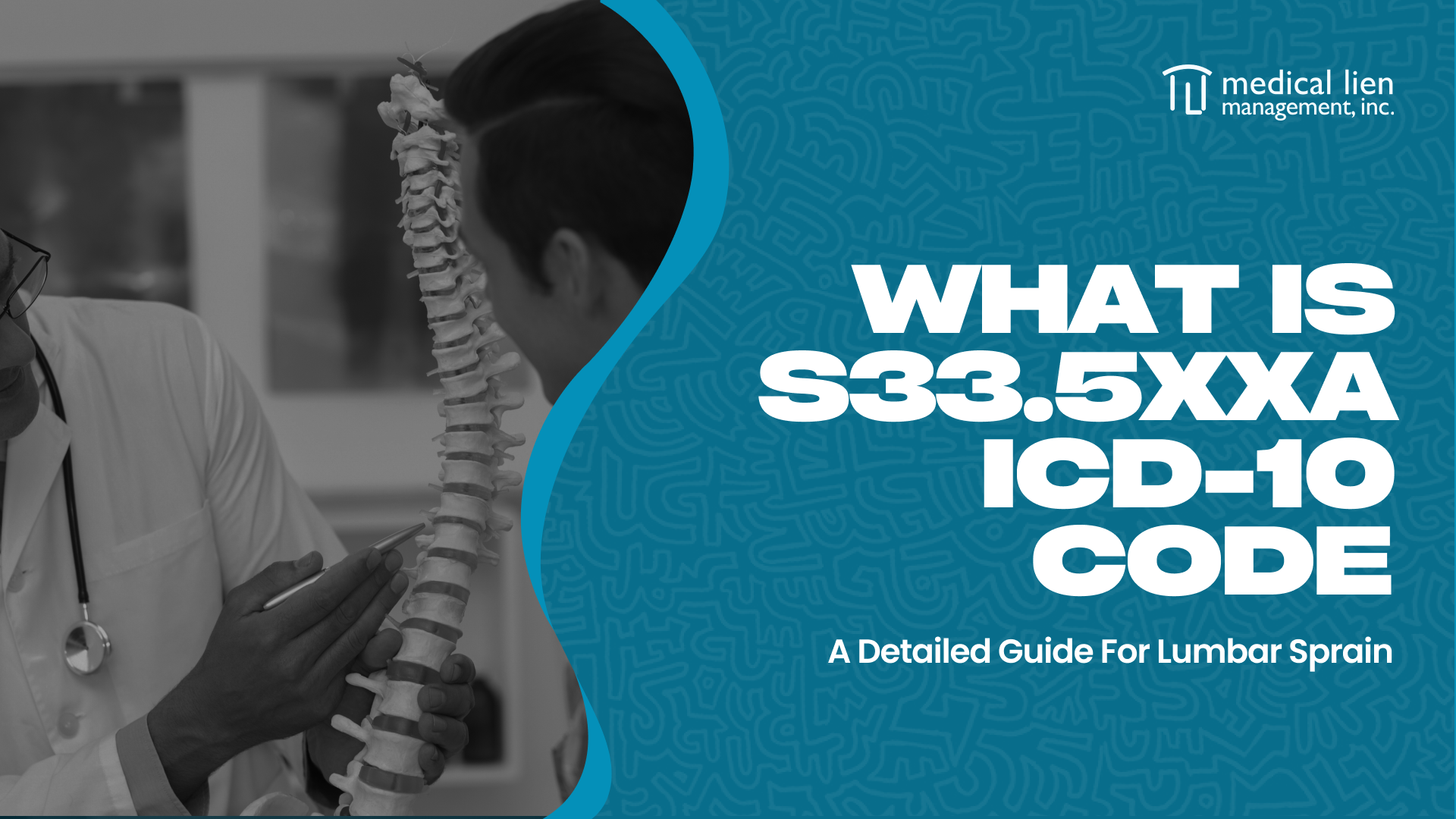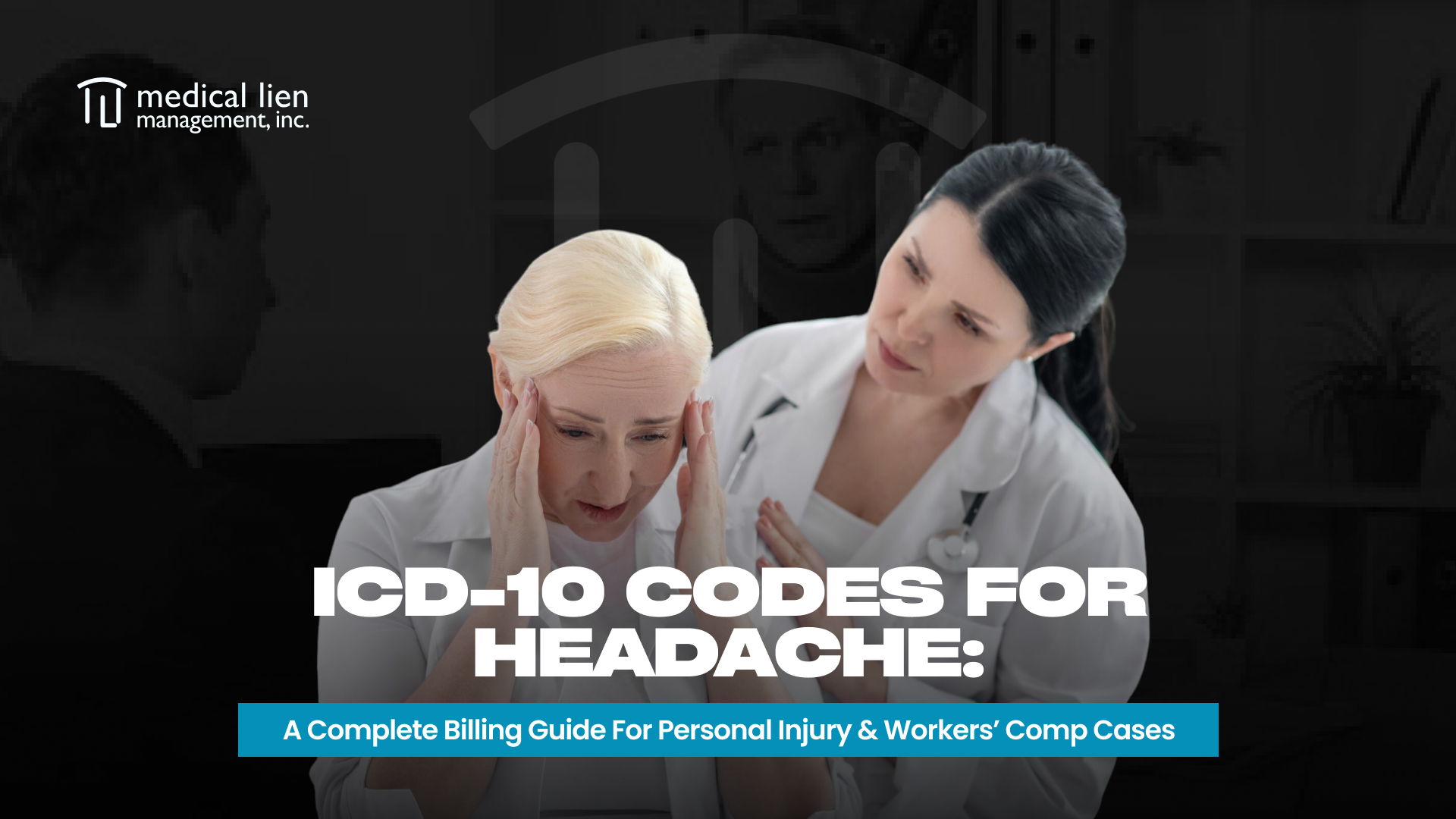If you treat patients after car accidents, work injuries, or falls, you’ve probably encountered lumbar sprains, often coded using S33.5XXA. But using this code incorrectly (or not using it at all) can reduce lien value, delay payment, or trigger denials.
You’re not alone if you’ve found this confusing.
This blog offers a complete billing guide for ICD-10 code S33.5XXA, from its clinical definition and proper use, to common CPT pairings, denial defense, and its significance in personal injury (PI) and workers’ compensation (WC) lien cases.
Let’s break down exactly how to use S33.5XXA to support accurate documentation, strengthen reimbursement, and protect your revenue.
What is the S33.5XXA ICD-10-CM Diagnosis Code?
Clinical Description
- ICD-10 Code: S33.5XXA
- Diagnosis: Sprain of ligaments of the lumbar spine
- Encounter: Initial (designated by the “A”)
This code describes acute injury to the ligaments in the lower back, typically due to trauma. It may present as lower back pain, stiffness, and reduced mobility and often requires a combination of physical therapy, rest, and pain management.
Code Classification
- Chapter: Injury, poisoning and certain other consequences of external causes (S00–T88)
- Section: Injuries to the lower back and pelvis (S30–S39)
- Subcategory: S33: Dislocation and sprain of joints and ligaments of the lumbar spine and pelvis
- Specific Code: S33.5: Sprain of ligaments of lumbar spine
Code Dependencies
S33.5XXA requires a 7th character to indicate the type of encounter:
- A: Initial encounter
- D: Subsequent encounter
- S: Sequela
Note: Claims without a valid 7th character will be denied or returned as incomplete.
When to Use ICD-10 Code S33.5XXA
This code should be used when a lumbar sprain is confirmed as the result of trauma and not simply generalized back pain.
Common Etiologies (Causes of Injury)
- Motor vehicle accidents (MVAs)
- Falls from heights or slipping
- Work-related lifting injuries
- Blunt trauma to the lower back
- Sports injuries involving the lumbar region
This diagnosis is particularly common in personal injury billing and workers’ comp cases where mechanical trauma leads to ligament damage.
Differentiating S33.5XXA from Similar Codes
| ICD Code | Description | Use When |
| M54.5 | Low back pain | Pain present, but without confirmed ligament injury |
| S39.012A | Strain of muscle, fascia and tendon of lower back | Soft tissue (muscle/tendon) involvement |
| S33.5XXA | Sprain of ligaments of lumbar spine | Confirmed ligament injury due to trauma |
Using S33.5XXA instead of a general code like M54.5 adds clinical and legal value by documenting injury severity and the specific structure involved.
Is S33.5XXA a Billable Code?
Yes, S33.5XXA is fully billable, provided the documentation supports the diagnosis and includes:
- A valid 7th character
- Detailed clinical notes tying the injury to an external event (accident, fall, etc.)
- Correlated CPT codes for evaluation and treatment
- Imaging or ROM tests when available
Improper or vague documentation can lead to denied claims or lien devaluation during settlement negotiations.
CPT Codes Commonly Linked to S33.5XXA
Pairing this diagnosis with the right CPT codes is essential to justify treatment and secure payment, especially in lien-based cases.
Evaluation and Management (E/M) Codes
- 99203–99205: New patient office visits (based on complexity)
- 99212–99215: Established patient visits
These codes document history, exam, medical decision-making, and are essential for every initial encounter.
Physical Medicine and Rehabilitation Codes
- 97110: Therapeutic exercises
- 97140: Manual therapy
- 97530: Therapeutic activities
- 97112: Neuromuscular re-education
- 97035: Ultrasound therapy
These codes support active rehab protocols used to treat lumbar ligament injuries.
Imaging and Diagnostic Codes
- 72100: Lumbosacral spine X-ray (2 or 3 views)
- 95851: ROM testing for the lumbar spine
- 20552: Trigger point injections (if needed for spasm or inflammation)
- 72148: MRI of lumbar spine (if necessary and supported by symptoms)
Diagnostic codes should match the timeline and findings of your treatment and bolster your documentation.
Other ICD-10 Codes Commonly Used for Lumbar Spine Problems
- S39.012A: Strain of muscle, fascia and tendon of lower back
- M54.5: Low back pain (general, non-traumatic)
- M51.2X1: Lumbago with sciatica, right side
- S33.6XXA: Sprain of sacroiliac joint
Selecting the most specific code, like S33.5XXA, helps support the claim’s legitimacy and value.
Why S33.5XXA is a Critical Code for Personal Injury Liens
In personal injury billing, the accuracy and specificity of your ICD-10 codes directly impact your reimbursement and lien defensibility.
Substantiating a Serious Injury
A lumbar sprain is a high-impact diagnosis that implies more than just pain. It signals actual ligament damage, inflammation, and the potential for prolonged impairment.
Using S33.5XXA instead of general codes like “backache” helps attorneys and adjusters:
- Understand injury severity
- Justify higher treatment costs
- Support the patient’s claim for pain and suffering
- Establish long-term prognosis
The Lien Lifecycle for a Lumbar Sprain
When coded correctly, your S33.5XXA lien goes through the following stages:
- Initial evaluation
- Rehab and documentation
- Lien filing and attorney coordination
- Settlement and lien negotiation
- Payment or reduction defense
Each of these phases requires accurate diagnosis and coding to secure the full value of your services.
The High Risk of Lien Disputes
Attorneys and insurance adjusters often question:
- Whether the lumbar sprain was pre-existing
- Whether care was prolonged unnecessarily
- Whether the diagnosis was vague or unsupported
Using S33.5XXA helps defend your lien against these common arguments, but only if it’s backed by clear, timely documentation.
Navigating Denials and Underpayments for S33.5XXA
Even with proper documentation and accurate use of S33.5XXA, claims can still be denied, delayed, or underpaid, especially in lien-based personal injury or workers’ compensation cases.
Understanding how to prevent and challenge denials can protect your revenue.
Common Reasons for Claim Denials
- Missing 7th Character
This code requires a 7th character (“A” for initial encounter). Missing it will trigger an automatic denial or “claim incomplete” status. - Inadequate Clinical Documentation
If the physician note doesn’t specify ligament damage, or doesn’t clearly tie the injury to an accident, payers may downcode or reject it. - Using Nonspecific Codes
Some providers mistakenly use general codes like M54.5 (low back pain), which don’t reflect the severity of the injury. These are often seen as subjective and not legally defensible. - Lack of Supporting CPT Codes
Without proper procedural codes (manual therapy, imaging, etc.), it’s hard to justify the level of care associated with lumbar ligament injury.
How to Fight S33.5XXA Denials
If your claim was denied, take these steps:
- Review the EOR (Explanation of Review): Understand the denial reason, missing data, unsupported diagnosis, coding error, etc.
- Check Documentation: Ensure notes include accident details, mechanism of injury, objective findings, and rationale for treatment.
- Submit a Second Review Appeal: In California, you have 90 days from receipt of the EOR to file a Second Bill Review (SBR) with corrections or additional documentation.
- File for Independent Bill Review (IBR): If the SBR is denied and you still disagree, file for IBR within 30 days and include the $195 filing fee. If ruled in your favor, the payer must reimburse the fee.
- Consult MLM for Case Support: At this stage, it helps to have lien experts like Medical Lien Management (MLM) manage the dispute process.
Are You Being Underpaid for Your Lumbar Sprain Lien Cases?
If you’re treating PI or WC patients with lumbar injuries, you’re often waiting months, or years, for payment. In the meantime, you’re carrying the costs of care, staff, admin time, and overhead.
This makes full reimbursement critical, not optional.
But here’s the reality:
- Insurance adjusters will challenge your codes
- Attorneys will negotiate down your liens
- Documentation gaps will be used to justify reductions
- You could lose revenue if the case drags or fails to settle
Without precise coding and proper follow-up, your lien could be devalued or dismissed altogether.
How Medical Lien Management Secures Your Full Reimbursement
At Medical Lien Management (MLM), we specialize in helping providers:
- Code correctly from the start
- Defend their liens with documentation
- Follow through on delayed or denied claims
- Recover more, faster, from PI and WC cases
Here’s what sets MLM apart:
Certified Coding & Billing Accuracy
Our in-house certified coders ensure ICD-10 and CPT codes align with documentation, treatment, and causality.
Jet Filing System
Proprietary technology that speeds up submissions, ensures compliance, and improves payer response time.
Attorney & Legal Team Coordination
We act as a liaison between your practice and the law firm handling the case, ensuring your lien is not overlooked or deprioritized.
Denial Management & IBR Handling
If a claim is denied, we handle Second Bill Reviews and IBR filings on your behalf, keeping your collections on track.
Detailed Reporting
You receive full visibility into where each lien stands, from billing to negotiation and final payment.
MLM turns fragmented lien billing into a systematic, revenue-generating process, so you can focus on patient care.
Get Paid in Full by Bringing Clarity to Your Revenue Cycle
Accurate coding, robust documentation, and experienced follow-up are the pillars of a successful healthcare revenue cycle for PI or WC liens.
If you’re coding for lumbar spine injuries, make sure:
- You use S33.5XXA where appropriate
- Documentation ties the injury to the event
- CPT codes align with services provided
- Your lien is managed proactively
Conclusion
Using S33.5XXA correctly can make the difference between full payment and partial write-off.
It’s not just a billing code, it’s documentation of a serious, trauma-related lumbar injury. When applied with the correct CPT codes and strong documentation, it supports:
- Medical necessity
- Case value for settlement
- Attorney negotiations
- Full and timely payment
But if it’s used improperly, or without proper follow-up, you risk losing out on deserved revenue.
Let MLM help you protect your bottom line.
With accurate coding, thorough documentation support, and end-to-end lien management, we ensure you get paid what you’re owed.
FAQs
What is diagnosis code S33.5XXA?
S33.5XXA is the ICD-10 code for a sprain of the ligaments in the lumbar spine, representing an initial encounter after a traumatic injury, such as from a fall or accident.
What is the ICD-9 code for S33.5XXA?
While ICD-9 codes have been replaced, the closest equivalent would be 847.2, which refers to “sprain of lumbar region.” ICD-10 offers more specificity through S33.5XXA.
What is a S33.5 sprain and strain of the lumbar spine?
This refers to ligament damage in the lower back, often due to overstretching or trauma. It differs from a muscle strain in that it involves the ligaments stabilizing the spine, not the soft tissues or muscle.
What is the ICD-10 code for initial sprain of ligaments of lumbar spine?
The full, billable code is S33.5XXA, where:
- S33.5 = sprain of lumbar spine ligaments
- XX = placeholder characters
- A = initial encounter





